
Leadership Message: Celebrate Campus Sustainability Month throughout October
Originally published by UC Davis Health
(SACRAMENTO) As we celebrate Campus Sustainability Month, it’s important to understand the three pillars of sustainability – social sustainability (impact on people), economic sustainability (financial impact), and environmental sustainability (impact on the natural environment). True sustainability occurs when the three pillars are balanced.
Dear Colleagues,
October kicks off Campus Sustainability Month, where institutions around the world engage and inspire campus stakeholders to become leaders in sustainability. As we celebrate what that means for us here at our growing health campus of UC Davis Health, I reflect on the framework I use to define “sustainability.”
I am asked many times, what exactly is sustainability anyways? By formal definition, sustainability is meeting the needs of the present without compromising the ability of future generations to meet their own needs. As this definition can still present as abstract, I like to remind others to simply look at the root word of sustainability, that being “sustain” or “sustainable,” and to know that synonyms are simply repeatable, maintainable, and supportable. That is really all we are talking about when searching for more sustainable solutions; can we maintain a process without depleting a resource or cause irreversible damage or harm to the environment, or ourselves as people.
I also choose to look at a more holistic definition of sustainability. Sustainability is often viewed through the lens of just the environmental impact. But there are two other areas of impact when addressing sustainability solutions. Known as the three pillars of sustainability, social sustainability (impact on people), economic sustainability (financial impact), and environmental sustainability (impact on the natural environment) make up what some organizations refer to as the triple bottom line. The three pillars of sustainability provide a framework for applying a solutions-oriented approach to complicated issues. Together the three pillars are meant to work in connection to one another with true sustainability occurring when they are balanced.
The reason being is understanding a simple concept in that, we as humans are not separate from the natural environment. We are one with the environment, and the environment is one with us. When we stop identifying ourselves as something separate from the natural environment, we start caring more for how we treat our nature environment. We likely wouldn’t harm ourselves outright, but when we pollute the natural environment, where we live, breathe, where our children play, where we grow the food we eat, we are in fact harming ourselves through this pollution.
We celebrated this concept in action this month as UC Davis Health hosted Clean Air Day on Oct. 5, where we acknowledged the privilege of clean air and all the enjoyable activities we love to do outside in the spirit of our own well-being. The three pillars of sustainability rely on balance between the three areas of impact. An institution can’t have a thriving fiscal bottom line, with unhappy employees or while polluting the natural environment and be considered a well-balanced institution. These elements work in harmony.
Additionally, efforts to be more environmentally sustainable can also benefit the economic sustainability of an organization. This is because sustainability solutions often look at the most streamlined solutions, hence saving an organization money. There is also built-in resiliency in this model. For example, during the pandemic we experienced many weaknesses in our nation and world’s supply chain because of commodities that relied on unsustainable materials.
To protect our ability to meet our supply chain demands, we can focus on the cradle-to-grave approach, looking at how our purchasing decisions today impact our operational costs and environmental impact later through the lens of material waste and emissions. This is built on the principle of what comes in must go out. So, what we buy and use now, will one day need to be addressed in terms of disposal. If we look at this approach holistically, in the end, this will not only save money, but it will yield many positive environmental impacts.
We need to build a world of sustainability solutions where everyone everywhere has equitable access to these solutions. No one should be left behind. Therefore, we all need to adopt a “we are all in this together” mindset about how we can look creatively at doing things differently in the spirit of environmental conservation. Social change is the driving force to creating lasting sustainability solutions.
Yours in health,
Kristina Cullen, M.B.A., LEED Green Associate
Sustainability Director
UC Davis Health
